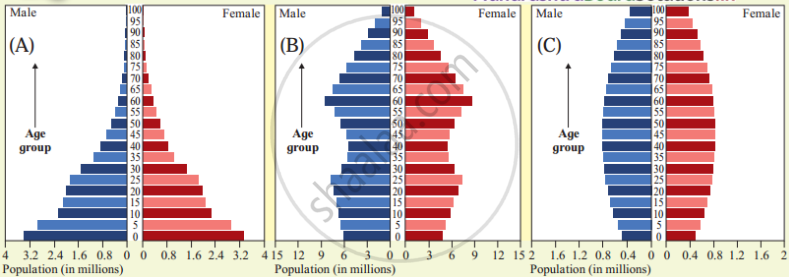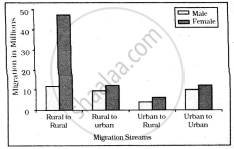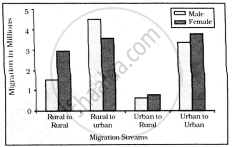Advertisements
Advertisements
प्रश्न
Give an account of the occupational structure of India’s population.
उत्तर
The population of India according to their economic status is divided into three groups, namely; main workers, marginal workers, and non-workers. It is observed that in India, the proportion of workers (both main and marginal) is only 39 percent (2001) leaving a vast majority of 61 percent as non-workers. This indicates an economic status in which there is a larger proportion of the dependent population, further indicating the possible existence of a large number of unemployed or under-employed people.
The occupational composition of India’s population (which actually means engagement of an individual in farming, manufacturing trade, services, or any kind of professional activities) shows a large proportion of primary sector workers compared to secondary and tertiary sectors. About 58.2 per cent of the total working population are cultivators and agricultural labourers, whereas only 4.2% of workers are engaged in household industries and 37.6% are other workers including non-household industries, trade, commerce, construction and repair and others. services. As far as the occupation of the country’s male and female population is concerned, male workers outnumber female workers in all three sectors. The number of female workers is relatively high in the primary sector, though in recent years there has been some improvement in the work participation of women in secondary and tertiary sectors.
The participation rate in secondary and tertiary sectors has registered an increase. This indicates a shift of dependence of workers from farm-based occupations to non-farm-based ones, indicating a sectoral shift in the economy of the country. The spatial variation of work participation rate in different sectors in the country is very wide. For instance, the states like Himachal Pradesh and Nagaland have very large shares of cultivators. On the other hand states like Andhra Pradesh, Chhattisgarh, Odisha, Jharkhand, West Bengal and Madhya Pradesh have a higher proportion of agricultural labourers. The highly urbanized areas like Delhi, Chandigarh and Puducherry have a very large proportion of workers being engaged in other services.
APPEARS IN
संबंधित प्रश्न
Write a short note on literacy rate.
Ratio of males and females in the population is ______.
A person who can write, read and do mathematical calculations in the country is known as ______.
Complete the chain
| Sr. No. | A | B | C |
| 1. | Expansive age pyramid | Low birth-death rate | High medical expenses |
| 2. | Constrictive age pyramid | Human capital | Unwillingness |
| 3. | Stationery age pyramid | Low number of old people | Demographic dividend |
| 4. | High working population | Problem of subsistence | Developed country |
| 5. | Migration due to drought | High number of old people | Economically backward |
Assertion: The working population classified according to occupations is known as occupational structure.
Reason: Occupational structure indicates development of a country.
Identify the incorrect factor
Regions having sex ratio more than one thousand:
Identify the incorrect factor
Factors having direct relation with literacy:
Observe the following graph and answer the question given below:

Questions:
- Which pyramid(s) represent(s) a country with high medical expenditure?
- Which pyramid(s) represent(s) a country with a large manpower?
- In which pyramid(s) the number of old people will be the least?
- What is the reason of the broad shape of A pyramid?
- Why C pyramid looks vertical in shape?
Observe the following graph and answer the question given below

Question:
- Which region has the highest literacy rate?
- Which region has the lowest literacy rate?
- In which region does women fare better than men in literacy rate?
- Write a concluding paragraph about the graph.
- Which is the type of graph?
Observe the following graph and answer the question given below:

Question:
- Which type of the graph shown above?
- In which age group male percentage is highest?
- In which age group female percentage is lowest?
- Whose percentage is highest in 30-39 age group?
- In which age group female percentage is higher than male percentage?
Write short note
Rural-urban structure of population
Which one of the following is the largest linguistic group of India?
Which states have a large rural population in India? Give one reason for such a large rural population.
Why do some states of India have higher rates of work participation than others?
Which country has the highest sex ratio in the world?
Name the country with the lowest sex ratio in the world.
Why have many European countries have deficit males?
How is occupational structure a good indicator of levels of economic development of a nation?
What was the percentage of urban population in the world in 2011?
How is sex ratio calculated in different countries of the world?
Why is the age structure considered an important indicator of population composition? Give one reason.
Why is sex ratio in some European countries recorded favourable to females? Give one reason.
Describe the main characteristics of each of the major groups of human occupations in the world.
Which state has the highest % of the rural population?
Which of these language families is predominant in India?
Which of the following is the largest religious minority in India?
How many scheduled languages are in our constitution?
Expanding population pyranrd shows.
Which type of age-sex pyramid is of Australia?
According to the UNO, how many countries have sex ratio unfavourable for females?
Which of the following programs sponsored by the central government aims at enabling the rural population to conserve water for drinking, irrigation, fisheries and afforestation?
Population of India according to Occupation can be categorized into:
The largest country in Asia Continent in terms of area ______
Study the given graph carefully and answer the following question:

Intra-state Migration by place of Last Residence Indicating Migration Streams India, 2011

Inter-state Migration by Place of Last Residence Indicating Migration Streams India, 2011
What is the main cause of male migration from rural to urban?
Table: India-Class-wise number of towns and cities and their population, 2011
| Class | Population Size | Number of Cities | Total Urban Population (in thousands) | % of Total Urban Population |
| I | 1,00,000 & more | 568 | 2,27,899 | 60-45 |
| II | 50,000-99,999 | 474 | 41,328 | 10-96 |
| III | 20,000-49,999 | 1,373 | 58,174 | 15-43 |
| IV | 10,000-19,999 | 1,683 | 31,866 | 8-45 |
| V | 5,000-9,999 | 1,749 | 15,883 | 4-21 |
| VI | less than 5,000 | 424 | 1,956 | 0-52 |
Source: Census of India-2011 and India 2017, Ministry of Information and Broadcasting, Government of India.
Which class town has the minimum urban population?
Sex ratio in the world is calculated as?
India's population as per the 2011 census is:
Which of the following is a major concern of study about the population of a country?
The lowest sex ratio in the world is in which country?
Consider the following statements and choose the ones which are correct.
- The world population on an average shows a sex ratio of 102 males per 100 females.
- According to UN, there are only 72 countries that have a favourable sex ratio for females.
- The sex ratio is lowest in Qatar.
Which group is also known as post-reproductive group?
Which type of population pyramid shows a bell shape?
Mining is a ______.
Arrange the following States/UTs in descending order in terms of their percentage of urban population as per the Census 2011.
- Delhi
- Kerala
- Maharashtra
- Assam
Arrange according to increase in age :
- Adults
- Children
- Old people
- Young people
Draw neat, labelled diagram:
Stationary pyramids
Which one of the following is the largest linguistic group of India?
Which one of the following is the largest linguistic group of India?
Which one of the following is the largest linguistic group of India?
Which one of the following is the largest linguistic group of India?
Which one of the following is the largest linguistic group of India?
